Read Part 1 from last Monday here.
I go back home.
Every time I close my eyes.
Cause there’s a whole other world out there
There’s blue skies and a breath of fresh air
Here in the city there’s too much fussin’ and fightin’
Wish I was back home where the fish are bitin’
Where mom and daddy have the radio on
Slow dancing to a sweet country song
Cotton candy at the county fair
There’s a whole other world out there
–The Derailers, “Whole Other World”
The Derailers’ dream is inviting, but pretty much horseshit. It’s been a trope in country music ever since, well, since the beginning. A lament of the loss of some imagined prelapsarian golden age that was consumed by the modern industrial world where value only exists in the cash nexus — stuck in Detroit City, wanting to go home, as if back home wasn’t just as much a part of the industrial order as the city. Still, it is a different world, it’s irresistible and it’s part of the soundtrack as we headed south.
HEADING SOUTH BEATS HEADING NORTH
When my grandfather died, my grandmother, stuck in the Michigan car factory town they had landed in, kept crying, “I just want to go home” — home being southern Illinois, where they had been driven out by both poverty and the promise of Michigan’s new industrial economy, a home that I saw through the rosy lens of my childhood visits there, and yearn, however foolishly, to recapture.
The trip to southern Illinois had begun on a gloomy Thursday when I had the misfortune of driving through campus and seeing a couple of Lex buses. Our spring break trip to Florida had been canceled, so going to Chicago for the weekend was a possible alternative. But coming across buses filled with the scions of Schaumburg and other vague nowhere places, Bud-Light-swilling lunkheads who aspire to a yuppie hive in River North at best, a McMansion in McHenry County at worst, gave me the same depressing feeling as seeing people lined up on Saturday night at Red Lobster or Chili’s or some other bland corporate shithole on North Prospect: pity. You sorry sons of bitches have no idea where you are, and thus, as Wendell Berry noted, who you are. Illinois is so much more interesting (or at least was) than the suburban ennui that engulfs most of the land these days. Well, my hypos are getting the upper hand of me, so…..
Time to light out for the territories, get to sea: a flashback tour into the oceanic past of southern Illinois; into that whole other world out there, one not quite past yet, living in a sea of shifting tenses. Plus, we had a hankering for some world-class BBQ, and you can get that in southern Illinois.
LABORING THROUGH A HIKE
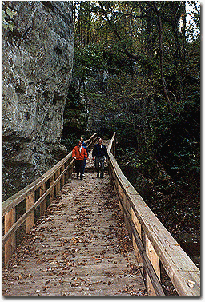 We’d had pretty good BBQ at a couple of places in the coal belt, and were on our way to lodgings and a third place for dinner when we decided to swing by Giant City State Park for a hike (Nina’s idea) instead of a nap (mine). I hadn’t been since I tagged along with a bunch of geologists from the Illinois State Geological Survey on a mission to correct the official story of how the big sandstone blocks — from which the park gets its name — came to be. Personally, I always liked the original story, which is that prehistoric giants created the city. The official explanation was that the sandstone blocks had fractured and slid down on the underlying shale.
We’d had pretty good BBQ at a couple of places in the coal belt, and were on our way to lodgings and a third place for dinner when we decided to swing by Giant City State Park for a hike (Nina’s idea) instead of a nap (mine). I hadn’t been since I tagged along with a bunch of geologists from the Illinois State Geological Survey on a mission to correct the official story of how the big sandstone blocks — from which the park gets its name — came to be. Personally, I always liked the original story, which is that prehistoric giants created the city. The official explanation was that the sandstone blocks had fractured and slid down on the underlying shale.
Pius Weibel, an ISGS geologist (and now chair of the Champaign County Board) decided this was nonsense, and showed that the formations were due to erosion along fractures in the sandstone. So it was both comic and pathetic to see, some 10 years later, that the old interpretation was still proclaimed on the trail signs leading to the formations. Maybe they should just go with the prehistoric giants theory and leave it at that.
Scientific (or cosmic) explanations aside, we took the difficult, strenuous hike through the formation. The guide says it’s a moderate hike but don’t believe it. Or don’t pig out on BBQ before you take it. Back in the car, sweating like, well, a pig (me, at least), we wound our way down to Makanda to check into the lodge before heading to Murphysboro for the anticipated highlight of the trip: world class ribs.
RIBS IN MAKANDA
Makanda is a funny place. Formerly a depot where local fruit was loaded into the rail system, it was basically a ghost town the last time I was here. A few people living in the hills and hollers, but the old commercial buildings were empty. Yet even in the early ’70s you could see what would happen. Back-to-the-land hippies, and artisans and artists from Carbondale gradually reclaimed it and made it into a destination. Some of those crusty old guys with gray ponytails dipping ice cream looked awful familiar, but I didn’t really want to know. There are a few artisan shops and whatnot, artists’ studios, and one shop that smells just like it was transferred from 1969 C’dale — you can get your incense and patchouli oil right here — in fact, you have to move upwind on the boardwalk if you want to avoid the aroma (or stench, depending on your sensibilities). Still, it’s nice to see a funky old place preserved. And it’s clearly a regional destination. Lots of folks with out-of-state plates were about on this weekend.
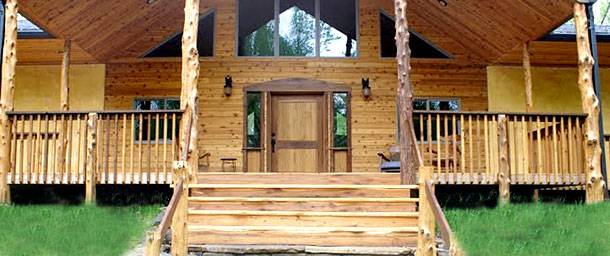 About a mile south is our lodge, The Makanda Inn, which is newly built — open less than a year. It’s an interesting bit of building, and even if you have no interest in going to the region or staying there, take a look at it just to see what can be done.
About a mile south is our lodge, The Makanda Inn, which is newly built — open less than a year. It’s an interesting bit of building, and even if you have no interest in going to the region or staying there, take a look at it just to see what can be done.
The owner (his daughter runs the place) is a guy from Chicago who went to SIU and fell in love with the area and bought about 18 acres. Interested in alternative, organic and energy-efficient construction techniques, he built the whole lodge out of straw bales. Not only that, but he employed local artisans using local materials to outfit the place in some exceptionally beautiful architectural details. The open lodge area on the lower level is built around a two story masonry fireplace (with a wood bread and pizza oven built in) that can basically heat the whole place with local woods, contains a full commercial kitchen, and a couple of comfortable seating areas looking out into the southern Illinois woods.
The place is not perfect in hostelry by any means, but I hope they work everything out, because I like what they’re trying to do — local, artisanal, environmentally friendly, and beautiful. Would that more people take this approach rather than more cinder block buildings housing chain motels and Chili’s.
ON DOWN TO MURPHYSBORO
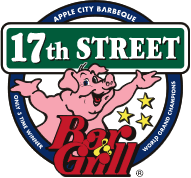 So after a short respite, we’re off to Murphysboro, home to Mike Mills, co-captain of the three-time Memphis BBQ Champeen Apple City BBQ team, and owner and pit master of the 17th Street Bar and Grill.
So after a short respite, we’re off to Murphysboro, home to Mike Mills, co-captain of the three-time Memphis BBQ Champeen Apple City BBQ team, and owner and pit master of the 17th Street Bar and Grill.
It’s Friday night and the joint is jumpin’ — a classic old tavern, filled with locals of all ages, faculty groups (I guess if you’re trying to lure a promising young scholar to SIU, your best bet is to fill them up on these ribs and promise them more if they sign on), and students over from Carbondale.
We open the menu, and there at the top is Mills’ Motto: “Life’s too short for the half-rack.” Truer words were never spoken, and our order confirmed it.
The sauce is good, very good. It’s moving over into the proper orange shade instead of red. Just a slight sweetness (still too much for me, but I’m a fanatic on this issue) but tangy with a savory, spicy richness and depth. It also has the proper consistency, meaning it is much thinner than those ketchupy or molassessy abominations.
While the pork is the make or break, sides still count. We tried the slaw, green beans, greens, and red beans and rice. The greens were good, cooked down to a rich mush and a perfect accompaniment and palate cleanser, and the green beans were more than adequate with the proper amount of smoky pork and onion in the mix. The slaw was very good but typical (hard to mess up slaw too much, although it can be done), although with a little better than average tang. The red beans and rice review was mixed. Props for the many little chunks of andouille sausage in the gravy, but demerits for the Uncle Ben’s style polished rice — I’m gonna write Mills and tell him to try some of the organic Louisiana brown rice now being produced. One other complaint: no fried okra.
But it’s the ribs. Rubbed in Mills top secret “Magic Dust” and cooked absolutely almost perfectly. My “almost” qualifier: apple wood — acceptable, since Murphysboro is the Apple City, but it’s not hickory. Still, as someone who never quite gets it right, I’m amazed when someone can get rib meat cooked so it’s succulent (but not falling off the bone), crisp (but not burnt/crusty or dry), and kissed with just the right amount of smoke. I’ve had ribs at only two places that can compete with these: Central BBQ in Memphis, and Arthur Bryant’s in Kansas City. This is the top of the line.
Mills, a crusty sort who was sitting at the table next to ours griping about Obama, has impressive and well-earned accomplishments: three times champion at Memphis in May (the Super bowl of Swine), and having his ribs named best in America by Bon Appetite magazine in 2007. The best praise though is from Playboy magazine which wrote: “the ribs are the equivalent of a culinary Valium: the world slows down a bit and all seems right in the world.” That’s exactly the experience of eating ribs on 17th street in Murphysboro.
MEANDERING OFF THE BBQ TRAIL
Heading out on Saturday, we had the more reasonable goal of hitting only two BBQ joints. Our first major destination though was the Spring Valley Social Brethren Church to pay respects to the dearly departed and to see what had changed (nothing, just more headstones). Since we were well south of Carbondale, and Spring Valley was well south of Harrisburg, we decided that instead of taking Illinois 13 across, we’d take the back roads. Well that only added a couple of hours to a 45-minute drive.
We had one of those state atlas gazetteers that are more than adequate in central Illinois, but of dubious value in the south. When that little red line goes from tiny to teeny it means one of three things: the road turns to gravel, the road turns to gravel before turning to dirt, the road just ends at some creek. It was pleasant nonetheless. First a short sojourn on the east side of Devil’s Kitchen Lake, enjoying the wide sandstone ledges above the water where we once skinny dipped and fished for crappie, and then hitting some of the little coal patch towns where a few of the kinfolk hail from. Dismal. We were lost, but eventually found (pause optional) the church, then headed to Harrisburg for lunch at storied Johnsons BBQ.
JOHNSONS IN HARRISBURG
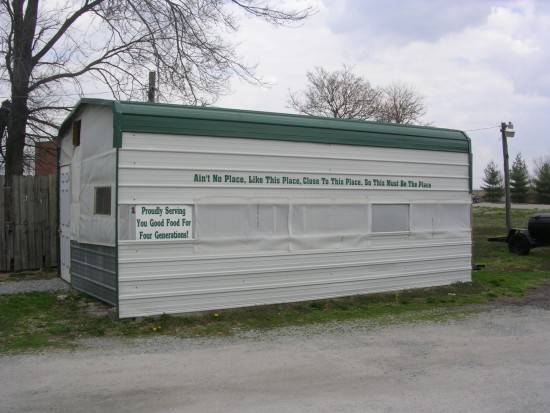
Rupert Johnson, the fourth in a BBQ lineage, has been at the same spot on the east side of Harrisburg for 26 years. He’s like most of the people in this region who originally came up at one time or another from other regions of the upland South — Tennessee, Kentucky, the Carolina high country — bringing their sublime cuisine with them.
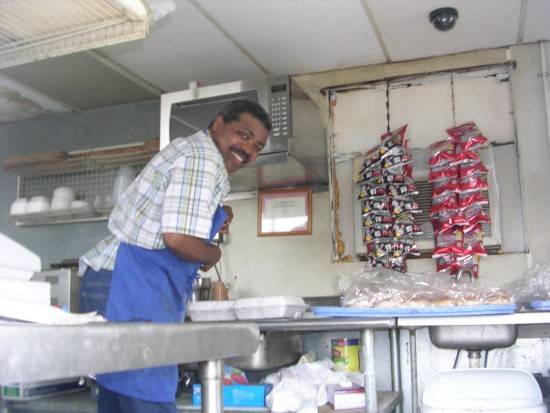
Rupert, (that’s him mopping some sauce on my sandwich in his little service trailer, and that’s his smoker above) is as nice a proprietor as you’d ever want to meet, but he could be mean as snakes and I’d still praise his BBQ to high heaven (I’ll praise Arthur Bryant’s BBQ to high heaven, too. And some of the people who work there are mean as snakes).
The secret rub, the high quality meat, the perfect hickory smoke, yes yes yes. The pork is sliced (it’s interesting the different ways BBQ is cut down here — chopped, shredded, sliced — a scientific comparative study needs to be done — can I get a grant?) and piled high, all well and good. But then comes the star of the show here: the sauce.
This is it — what we’ve been looking for: slightly hot and tangy, vinegary and a little mustardy maybe, with black and red pepper flavor, the sweetness just a properly slight undercurrent, a hint of tomato but none of that ketchupy flavor, and a whiff of savory spices. Just go order some, (if you don’t like it, I’ll buy it) or head straight south on US 45.
FURTHER ALONG, WE’LL KNOW MORE ABOUT IT
We decided to drive over to old Shawneetown and eat our lunch by the banks of the O-hi-O.
I thought about singing a few bars and asking Nina to take a little walk with me, but didn’t think she’d appreciate it. Old Shawneetown used to be just Shawneetown until the federal government decided in the 1940s to move the town up the hill and build New Shawneetown after the latest of a long series of devastating floods.
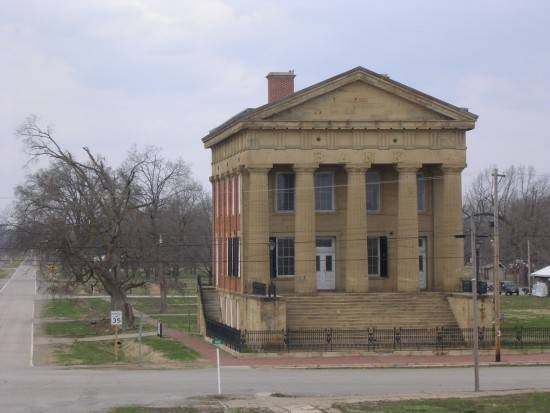 I hadn’t been to the old town since I was a kid. I remembered a 19th century downtown with many antebellum buildings, but a place gone to seed and made up of mostly bars filled with river rats and codgers. It was shocking to discover that the town was basically gone. The old bank building (right) and the house where the first bank in Illinois was located remain as they are protected historic buildings. One other downtown building remains with a large addition, a huge biker bar called Hogdaddy’s, which appears to be a regional gathering place. Everything else downtown was gone gone gone. The town was about as derelict as you can get: old trailers, ratty houses, un-collared dogs running everywhere. I half expected a meth lab to blow while we were there.
I hadn’t been to the old town since I was a kid. I remembered a 19th century downtown with many antebellum buildings, but a place gone to seed and made up of mostly bars filled with river rats and codgers. It was shocking to discover that the town was basically gone. The old bank building (right) and the house where the first bank in Illinois was located remain as they are protected historic buildings. One other downtown building remains with a large addition, a huge biker bar called Hogdaddy’s, which appears to be a regional gathering place. Everything else downtown was gone gone gone. The town was about as derelict as you can get: old trailers, ratty houses, un-collared dogs running everywhere. I half expected a meth lab to blow while we were there.
It’s hard to imagine that this was once the hub of Illinois. It was the entrepot for people entering Illinois after flat-boating down the Ohio from Pennsylvania, and it held the federal land patent and registrar’s office. It was thus the banking center, and all-around center of commerce in Illinois. The story is often told of how the Shawneetown bankers once refused a loan to Chicago because that stinking swamp was obviously never going to amount to anything. [The more banking changes, the more it stays the same.]
A couple of old Shawneetown stories from an acquaintance in the region: He took his friend, a Chicago architect, to a Shawneetown bar. The bar maid suspiciously eyes the architect and asks, “what’ll you have?”
“I’ll have a bottle of Heineken.”
“No Heineken……….Pabst.”
“OK, I’ll have a bottle of Pabst.”
“No bottles…………. cans.”
And there’s a reason for that. A different time, and a new patron asked directions to the men’s room. Pointed to a door at the rear, he went through it and found himself standing on the levee, which was indeed the men’s room for beer drinkers.
Despite its colorful history, Shawneetown is kind of a bummer today, despite the lovely view once you turn your back on it and watch the Ohio River flow by, so we headed back west.
DIXIE BBQ IN JONESBORO
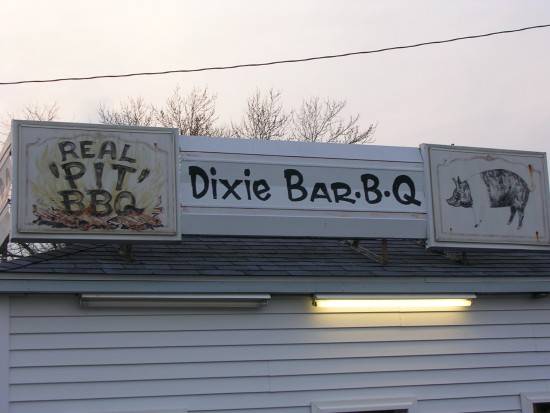
Our final BBQ stop was in Jonesboro at the Dixie BBQ, which I had remembered as being pretty good. Certainly their signage is first rate, but it’s really more of a hamburger stand these days; no ribs, although the BBQ pork sandwich is the mainstay. While waiting for our order to arrive, we were entertained by the family at the next table. At the head was the family patriarch, a raw-boned country man in his 60s or 70s, a couple of silent sons with their wives, and a granddaughter who had her nose in a book the whole time the patriarch extolled on a variety of topics. Despite being able to hear him clearly, we didn’t have a clue what he was talking about — it was like listening to Boomhauer on King of the Hill. We were highly amused and imagined the scene with the granddaughter before dinner — “I don’t want to go! Grandpa just talks and talks about boring old things.” “OK, you can take a book if you want to.”
Still waiting for our order, I went and read the usual newspaper review columns affixed to the wall. One was a Chicago Tribune review from when Jim Edgar was governor and quoted Edgar as saying Dixie was always the first place he went to for BBQ when in southern Illinois.
The BBQ was pretty disappointing; not bad, but uninspired, middle of the road fare that leaves you with that “eh” feeling. It looked good, almost as good as the sign, as handsome as Jim Edgar, but was very bland pork (I suspect it was loin instead of the proper butt or shoulder) with only the slightest hint of smoke. The sauce was icky sweet — tasted like peaches (a local crop) to me — and mundane, with no real presence or spice anywhere. The Jim Edgar tout made sense.
SUMMING IT UP
On a rainy Sunday morning we drive home with a stash of BBQ leftovers and several bottles of sauce. Our talk about the weekend in Egypt is tinged with melancholy as we attempt to sharpen vague memories to explain the pull a particular place can have on you. I’ve always liked the food in southern Illinois, but there was more to it than food. The aimless wandering seeing sights was part of it, both then and now, but we realized it was the stories and the memories, the tales of the ancestors that make up culture.
As a kid in Harrisburg we’d sit on the front porch of one of my great aunts who lived across the street from each other, waving at everyone who drove by, listening to the stories. Later we’d eavesdrop on the grownups from our pallets on the living room floor. They were wandering stories of mundane things, who was having trouble with whom, local and family history, and all the fine-grained tales of common life that made it seems so much more interesting there than the scrubbed life in Urbana, where we were taught to never say ain’t (which I thought then, and still think, just ain’t right).
Culture is in the telling of stories, as opposed to having them told to you over the big TV over the bar at your favorite corporate franchise restaurants: cooked up outrages, shaming, backstabbing competition, and the rest. That’s the reality show framing of human interaction in the world of suburban idiocy.
Shards of cultural memory slowly emerge to the beat of the wipers: Poke salat, poultices for boils, killing and preparing the chicken for Sunday dinner, menus for the church suppers, the kindness and sweetness of the church ladies (when they weren’t ecstatically rolling in the aisles), November hog slaughter and making head cheese, how to skin rabbits, squirrels and catfish, summer kitchens to put up beans and other vegetables, setting trot lines, shootings over someone messing with someone else’s jug line on Crab Orchard Lake, tales of hometown Robin Hood hero Charlie Birger buying groceries for the destitute.
Yet underneath it all was bad liquor and alcoholism, poor diet, poverty, violence, death from self-induced abortions, nasty dangerous coal pits, black lung and environmentally horrific strip mines, racism, patriarchy, terrifying religion offering ecstatic escape from a brutal world. Lives were-and in many ways still are — hard, truncated, intellectually and emotionally stunted, bigoted, and often just plain mean-spirited. Still, it’s a beautiful place with many beautiful people.
Not that long ago down here, miners were Italians, Cornishmen, upland southerners (including Cherokee who slipped off the Trail of Tears, and Melungeons), African-Americans, Bulgarians, Slovakians and every other ethnicity from the Austro-Hungarian Empire. Living side by side with German farmers [the Kornthal church south of Jonesboro is worth a visit to see the Austrian Kirche style and the original German signage and decoration], decedents of original French le habitants, African- American refugees from the post civil war South, bored native Scots-Irish farm-boys like the Sheltons, Jewish merchants (Charlie Birger was a Jew born in Lithuania, raised in St. Louis and started out as a grocer to miners in the little coal patch of Ledford west of Harrisburg), they all made up a rich and diverse culture — however raw and low it was. Not all that different from many other places in industrial America in that regard.
Whatever was, it all seems to disappear as you drive down a major road like Illinois 13, or as you go into the hollowed-out towns that dot the region. Few signs of old ethnicities remain, outside of Herrin’s Italians. Local business is now the BBQ if the town is so lucky, and maybe a Casey’s or Huck’s; perhaps if it’s prosperous enough the town has a local café, and a few antique malls. The decline of the coal industry is of course a major reason, but as you drive across Illinois 13 the artifacts of another powerful reason — the accelerating shift from production to consumption, funded by the explosion in personal and business debt, floating on a sea of bubbles — are seen in the disposable chain store buildings, strip malls, mega-churches, and the rest of the cheap-motor-fuel development that helped hollow out the towns and that pumps money out of the region and into corporate coffers. It all seems the same as anywhere.
There are other major economic forces here — SIU’s growth has had a huge effect over the past half century, as has the recent growth industry of federal and state prisons. Fruit production remains as a stabilizing industry, and in some of the alluvial areas, corn and beans bring in cash (mostly from the federal government, but that’s another story). But behind the façade of buildings lining Illinois 13 you still see hard-scrabble, despite all the economic development schemes like fish farms, wineries, tourism, big agricultural processing and shipping facilities along the rivers, and the (one hopes futile) attempts to revivify extractive industries like coal. It feels like limbo. What’s coming is anybody’s guess, but what was is as gone as Shawneetown.
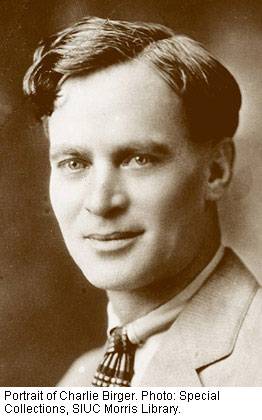 Time was when the stories about Charlie Birger, the most colorful character to come out of southern Illinois, were legion. Not so much anymore. But they are good stories, so let’s wind up with a taste: Birger was a popular merchant in Ledford as he had a cigar box full of coins that he would occasionally fetch when kids came around his store and he’d toss them out like candy at a parade; a precursor to his buying groceries and anonymously leaving them on the doorsteps of out-of-work miners’ families. He’d been in the army in the west as a young man and was an expert horseman, working as a broncobuster on a ranch after being discharged. [Stories that he hung out with Butch Cassidy and The Sundance Kid have never been proven].
Time was when the stories about Charlie Birger, the most colorful character to come out of southern Illinois, were legion. Not so much anymore. But they are good stories, so let’s wind up with a taste: Birger was a popular merchant in Ledford as he had a cigar box full of coins that he would occasionally fetch when kids came around his store and he’d toss them out like candy at a parade; a precursor to his buying groceries and anonymously leaving them on the doorsteps of out-of-work miners’ families. He’d been in the army in the west as a young man and was an expert horseman, working as a broncobuster on a ranch after being discharged. [Stories that he hung out with Butch Cassidy and The Sundance Kid have never been proven].
He loved putting on his riding get up (some people said he resembled silent movie cowboy star Tom Mix) and doing elaborate riding maneuvers down the main street of Harrisburg. He was semi-respectable in Harrisburg, which he aimed to make crime free — the bad stuff banished to the outlying areas — for his and others’ children, and he hobnobbed with the respectable burghers. But he was a cold-blooded killer, too (although after killing one rival gangster he vomited and said, “I don’t know what’s wrong with me. Every time I kill somebody I get sick to my stomach”). Convicted of arranging the slaying of a politician who was giving the Sheltons cover, Birger always denied killing him, but thought the conviction was fair enough, since he had killed others, “but never anybody who didn’t deserve it.”
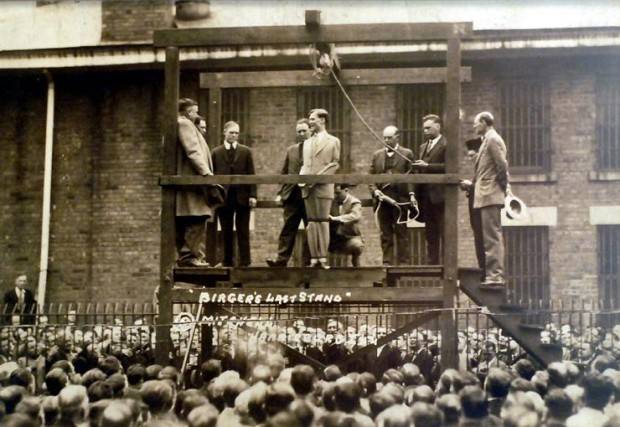
Led to the gallows on a blue-skied April morning in 1928, Birger seemed at ease and was smiling, shaking hands with his executioners, taking a breath of fresh air. Moments before having a black hood placed over his head (he had refused the white hood option by saying he didn’t want anyone mistaking him for one of those “damned Kluxers”), he looked out over the crowd below, and at those seeking a better view from the budding trees, and said, “It is a beautiful world.”
It is. And I’m looking forward to getting back. It’s a whole other world out there, or was. Plus, I’ve got some new leads on a few BBQ joints to check out, and hope to hear some new old stories.








